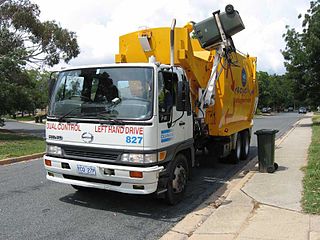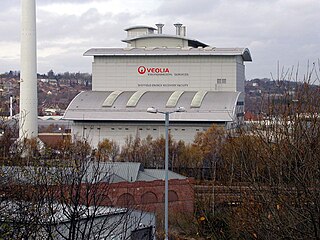
Pollution is the introduction of contaminants into the natural environment that cause adverse change. Pollution can take the form of any substance or energy. Pollutants, the components of pollution, can be either foreign substances/energies or naturally occurring contaminants.
Environmental geology, like hydrogeology, is an applied science concerned with the practical application of the principles of geology in the solving of environmental problems created by man. It is a multidisciplinary field that is closely related to engineering geology and, to a lesser extent, to environmental geography. Each of these fields involves the study of the interaction of humans with the geologic environment, including the biosphere, the lithosphere, the hydrosphere, and to some extent the atmosphere. In other words, environmental geology is the application of geological information to solve conflicts, minimizing possible adverse environmental degradation, or maximizing possible advantageous conditions resulting from the use of natural and modified environment. With an increasing world population and industrialization, the natural environment and resources are under high strain which puts them at the forefront of world issues. Environmental geology is on the rise with these issues as solutions are found by utilizing it.

Waste management or waste disposal includes the processes and actions required to manage waste from its inception to its final disposal. This includes the collection, transport, treatment, and disposal of waste, together with monitoring and regulation of the waste management process and waste-related laws, technologies, and economic mechanisms.

Incineration is a waste treatment process that involves the combustion of substances contained in waste materials. Industrial plants for waste incineration are commonly referred to as waste-to-energy facilities. Incineration and other high-temperature waste treatment systems are described as "thermal treatment". Incineration of waste materials converts the waste into ash, flue gas and heat. The ash is mostly formed by the inorganic constituents of the waste and may take the form of solid lumps or particulates carried by the flue gas. The flue gases must be cleaned of gaseous and particulate pollutants before they are dispersed into the atmosphere. In some cases, the heat that is generated by incineration can be used to generate electric power.

Waste hierarchy is a tool used in the evaluation of processes that protect the environment alongside resource and energy consumption from most favourable to least favourable actions. The hierarchy establishes preferred program priorities based on sustainability. To be sustainable, waste management cannot be solved only with technical end-of-pipe solutions and an integrated approach is necessary.

Waste-to-energy (WtE) or energy-from-waste (EfW) is the process of generating energy in the form of electricity and/or heat from the primary treatment of waste, or the processing of waste into a fuel source. WtE is a form of energy recovery. Most WtE processes generate electricity and/or heat directly through combustion, or produce a combustible fuel commodity, such as methane, methanol, ethanol or synthetic fuels.

Kerbside collection or curbside collection is a service provided to households, typically in urban and suburban areas, of collecting and disposing of household waste and recyclables. It is usually accomplished by personnel using specially built vehicles to pick up household waste in containers that are acceptable to, or prescribed by, the municipality and are placed on the kerb.

The Sheffield Energy Recovery Facility, also known as the Energy from Waste Plant, is a modern incinerator which treats Sheffield's household waste. It is notable as it not only provides electricity from the combustion of waste but also supplies heat to a local district heating scheme, making it one of the most advanced, energy efficient incineration plants in the UK. In 2004, the district heating network prevented 15,108 tonnes of CO2 from being released from buildings across the city, compared to energy derived from fossil fuels. The incinerator is a 'static asset' owned by Sheffield City Council and operated by Veolia Environmental Services under a 35 year integrated waste management contract (IWMC)/PFI contract.

WE ACT for Environmental Justice is a nonprofit environmental justice organization based in Harlem, Manhattan, New York City. The organization was founded in March 1988 to mobilize community opposition to the city's operation of the North River Sewage Treatment Plant, and the siting of the sixth bus depot in Northern Manhattan.
Ecological design or ecodesign is an approach to designing products and services that gives special consideration to the environmental impacts of a product over its entire lifecycle. Sim Van der Ryn and Stuart Cowan define it as "any form of design that minimizes environmentally destructive impacts by integrating itself with living processes." Ecological design can also be defined as the process of integrating environmental considerations into design and development with the aim of reducing environmental impacts of products through their life cycle.
Environmental issues in Brazil include deforestation, illegal wildlife trade, illegal poaching, air, land degradation, and water pollution caused by mining activities, wetland degradation, pesticide use and severe oil spills, among others. As the home to approximately 13% of all known species, Brazil has one of the most diverse collections of flora and fauna on the planet. Impacts from agriculture and industrialization in the country threaten this biodiversity.
Waste management in Japan today emphasizes not just the efficient and sanitary collection of waste, but also reduction in waste produced and recycling of waste when possible. This has been influenced by its history, particularly periods of significant economic expansion, as well as its geography as a mountainous country with limited space for landfills. Important forms of waste disposal include incineration, recycling and, to a smaller extent, landfills and land reclamation. Although Japan has made progress since the 1990s in reducing waste produced and encouraging recycling, there is still further progress to be made in reducing reliance on incinerators and the garbage sent to landfills. Challenges also exist in the processing of electronic waste and debris left after natural disasters.
Co-processing is the use of waste as raw material, or as a source of energy, or both to replace natural mineral resources and fossil fuels such as coal, petroleum and gas in industrial processes, mainly in energy intensive industries (EII) such as cement, lime, steel, glass, and power generation. Waste materials used for Co-processing are referred to as alternative fuels and raw materials (AFR).
Paul James Lioy was a United States environmental health scientist born in Passaic, New Jersey, working in the field of exposure science. He was one of the world's leading experts in personal exposure to toxins. He published in the areas of air pollution, airborne and deposited particles, Homeland Security, and Hazardous Wastes. Lioy was a professor and division director at the Department of Environmental and Occupational Health, Rutgers University - School of Public Health. Until 30 June 2015 he was a professor and vice chair of the Department of Environmental and Occupational Medicine, Rutgers University - Robert Wood Johnson Medical School. He was deputy director of government relations and director of exposure science at the Rutgers Environmental and Occupational Health Sciences Institute in Piscataway, New Jersey.

Trashed is an environmental documentary film, written and directed by British film-maker Candida Brady. It follows actor Jeremy Irons as he investigates the global scale and impact of humanity's modern wasteful consumerism and pollution. The film is a call for urgent action to resolve the issue of existing deposits and drastically reduce our consumption towards sustainable levels and zero waste, but also demonstrates how this is already being achieved successfully in many communities around the world.
The Essex County Resource Recovery Facility, also known as Covanta Essex, is a waste-to-energy incineration power station in Essex County, New Jersey, United States. Opened in 1990, it is owned by the Port Authority of New York and New Jersey (PANYNJ) and operated by Covanta Energy. It is located adjacent to the New Jersey Turnpike between Raymond Boulevard and the Passaic River in Newark.
Greenaction for Health and Environmental Justice, formed in 1997, is a multiracial grassroots organization based in San Francisco that works with low-income and working class urban, rural, and indigenous communities. It runs campaigns in the United States to build grassroots networks, and advocate for social justice.
Environmental issues in Toronto encompasses all those concerns and opportunities presented by the environment of Toronto. Many are harmful effects, such as the pollution of air and water, while others are factors influenced by urban infrastructures such as highways and public transportation services. As a result of the city's large population, substantial waste is produced annually.

Waste management in Australia started to be implemented as a modern system by the second half of the 19th century, with its progresses driven by technological and sanitary advances. It is currently regulated at both federal and state level. The Commonwealth's Department of the Environment and Energy is responsible for the national legislative framework.

The Delaware Valley Resource Recovery Facility is a trash incineration plant located in Chester, Pennsylvania. The waste-to-energy plant, which incinerates waste to generate power, was built and operated by Westinghouse from 1991 to 1997. It is currently operated by Covanta. a Morristown, New Jersey-based publicly-traded industrial waste company, and has been criticized for the level of pollution it produces. The plant has the largest capacity of any waste-to-energy plant in the United States.









